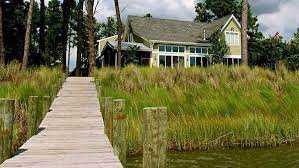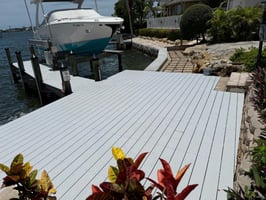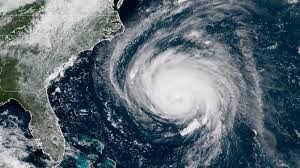How to Prevent Erosion on Your Waterfront Property
You'll want to take as many preventative measures as possible to ensure your waterfront property stays in the family for generations to come. After all, erosion is a natural process that occurs on any shoreline. You can protect your property from erosion and ensure that it remains your family's waterfront home for years.
If you own waterfront property and live in an area with heavy rainfall or accessible rivers, there's a chance that erosion could pose a threat to the integrity of your land. Routinely monitoring the ground around your property is one way to monitor any potential danger posed by erosion. If you suspect that erosion may be an issue with your waterfront property, there are some things you can do before it becomes too late.
 Install a seawall
Install a seawall
A seawall is a wall constructed along the shore to prevent erosion and protect buildings and other structures from waves. Seawalls can be built from concrete blocks, boulders, and rocks. They can also be made from wood, metal, or reinforced concrete.
If you install a seawall in your yard, you should follow these tips:
First, check with your local building department for guidelines on how high and wide to build your seawall. You want to make sure it’s high enough to protect your home from flooding and strong enough to withstand strong waves.
The length of your seawall also matters; the longer it is, the more likely it will stand up to large waves. Finally, there are many ways you can build a seawall. If you have lots of room, you can use a single massive rock as a base and add smaller rocks along the outside edge of your property.
If you have fewer options but still want something substantial looking, consider using bricks or blocks instead of large rocks. Either way, ensure the seawall is sturdy enough to hold up against large waves.
Keep your soil healthy.

When your soil is healthy, it's better able to withstand the natural forces of erosion. Healthy soil can retain moisture longer, preventing it from running off the land and causing decay. Healthy soil is also able to resist the forces of potential flooding better.
You can help keep your soil healthy by applying compost to the land around your waterfront property. Compost helps to reduce the amount of soil erosion by helping sandy or loamy soil to retain more water and nutrients. You can also help keep your soil healthy by planting grasses and other plants along the waterfront.
 Install Riprap/Revetment
Install Riprap/Revetment
Riprap/Revetment is often a key element in flood mitigation projects. It can be used to reduce erosion, stabilize slopes, and create habitats for wildlife. It's also an essential step in floodproofing your property.
There are two main types of riprap:
- Formed and Fabricated. Formed riprap is made from rocks piled up into roughly rectangular blocks that are then covered with soil and compacted. The advantages of formed riprap are that it's relatively easy to build, and there are no transportation or installation costs. The disadvantages are that it requires more manual work, is less durable than fabricated riprap, and may not be able to withstand high flows.
- Fabricated riprap is made by cutting smaller pieces of rock from the edge of the bank and assembling them into a plank-like structure that can be easily moved if needed (e.g., due to heavy rains). Fabricated riprap is more durable than formed riprap and can withstand higher flows than formed riprap. The advantage of fabricated riprap is that it requires less manual work than formed riprap.
Create grassed erosion barriers

If you can't install boulders and rocks along your waterfront due to the natural landscape of your property, you may want to consider creating a grassed erosion barrier. An erosion barrier is a shallow pit filled with grasses and other plants to help prevent soil erosion.
An erosion barrier can help prevent soil erosion by slowing the flow of water and trapping sediment. Erosion barriers are particularly effective in tidal areas, where water levels rise and fall throughout the day. An erosion barrier needs to be around 3 feet wide and 3 feet deep, with the top of the barrier being lower than the surrounding water levels.
Conclusion
Erosion can be a severe concern to waterfront homeowners, so it's essential to take preventative measures to protect your property.
If you own waterfront property, it's necessary to regularly monitor erosion to ensure it doesn't become a severe problem. You can identify potential signs of erosion by walking the shoreline of your property. You can also hire a professional to conduct a more in-depth erosion inspection. To prevent erosion on your waterfront property, install a seawall, keep your soil healthy, install a riprap or a revetment, and create grassed erosion barriers.
If you have questions or concerns about your property's current condition or integrity. You can contact Precision Marine Construction Inc. (PMC) professionals for a free inspection and estimate. PMC provides full service to the commercial and residential marine industries. If you require assistance or have questions, call PMC at 941.924.6044, and one of our trained professionals will assist you with any questions.




Blog comments